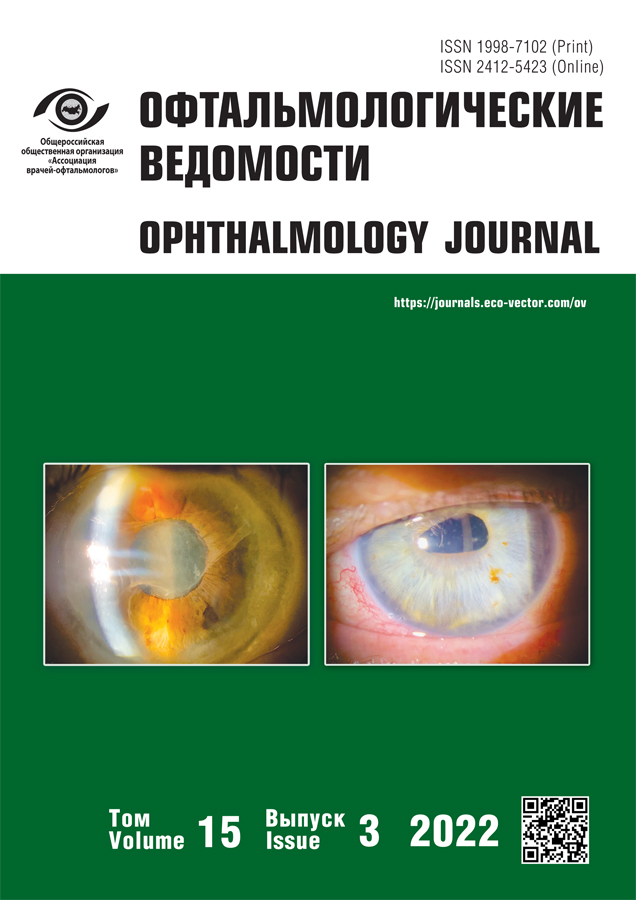Transconjunctival internal decompression of the orbit in patients with endocrine ophthalmopathy: a retrospective analysis
- Authors: Davydov D.V.1,2
-
Affiliations:
- National Medical Research Radiological Center
- Peoples’ Friendship University of Russia
- Issue: Vol 15, No 3 (2022)
- Pages: 29-37
- Section: Original study articles
- Submitted: 03.10.2022
- Accepted: 25.10.2022
- Published: 21.12.2022
- URL: https://journals.eco-vector.com/ov/article/view/111178
- DOI: https://doi.org/10.17816/OV111178
- ID: 111178
Cite item
Abstract
BACKGROUND: The most characteristic manifestation of endocrine ophthalmopathy (EO) is the proptosis development in a patient. It is possible to correct the displacement of eyeballs by performing an orbital decompression surgery.
AIM: To evaluate the clinical efficacy of treating patients with endocrine proptosis using transconjunctival internal decompression of the orbit.
MATERIALS AND METHODS: The study included 86 orbits of 43 patients with bilateral proptosis. All patients underwent MSCT examination, proptosis was detected due to an increase in the soft tissue component. Transconjunctival decompression of both eye sockets was performed according to the described method, and the amount of eyeball displacement after surgery was investigated.
RESULTS: Patients’ complaints about constant pressure behind the eye, observed in 39 patients, disappeared during the first day after surgery in 21 patients, in the remaining patients they gradually disappeared within a week. In 32 patients with preoperative diplopia after surgery, in 27 it completely disappeared, in the remaining 5 it remained in the extreme positions. 6 months after surgery, a decrease in proptosis amount from 21.1 ± 1.5 mm to 20.6 ± 1.5 mm was noted, visual acuity was 1.0 ± 0.02, decreased visual acuity remained in 3 cases due to the incipient cataract, IOP decreased from 20 ± 1.2 mm Hg to 19 ± 1.3 mm Hg. There were no eyeball movement restrictions at the control examination.
CONCLUSIONS: Internal (soft tissue) decompression of the orbit is an effective method for proptosis correction exophthalmos in patients with lipid EO form. Carrying out the decompression surgery through the conjunctival access allows to constantly monitor the shape and size of the pupil in the operated orbit, to conduct controlled hemostasis of the orbital tissues. The use of preliminary calculations of the volume of soft tissues to be removed (according to MSCT) makes it possible to obtain a predictable effect of the surgery in variable degrees of proptosis. Transconjunctival decompression helps avoiding cicatricial processes of the eyelid skin.
Full Text
About the authors
Dmitry V. Davydov
National Medical Research Radiological Center; Peoples’ Friendship University of Russia
Author for correspondence.
Email: d-davydov3@yandex.ru
ORCID iD: 0000-0001-5506-6021
Professor, Head of the Department of Oncoplastic Surgery, Head of the Department of Reconstructive Plastic Surgery with a course of ophthalmology
Russian Federation, Moscow; MoscowReferences
- Kochetkov PA. Aspects of endocrine ophthalmopathy surgical treatment by ENT specialist. Clinical and experimental thyroidology. 2017;13(3):29–35. (In Russ.) doi: 10.14341/ket2017329-35
- Chzhu Vehn’. Otsenka ehffektivnosti razlichnykh metodov dekompressii orbity pri ehndokrinnoi oftal’mopatii [dissertation abstract]. Saint Petersburg, 2022. 22 p. (In Russ.)
- Kalandari AA. Dekompressiya orbity u patsientov s ehndokrinnoi oftal’mopatiei [dissertation abstract]. Moscow, 2021. 48 p. (In Russ.)
- Brovkina AF, Aubakirova AS. Internal orbital decompression in uncompensated edematous exophthalmos. The Russian annals of ophthalmology. 2006;122(3):3–5. (In Russ.)
- Aubakirova AS. Dekompressiya orbity kak reabilitatsionnoe meropriyatie pri ehndokrinnoi oftal’mopatii [dissertation abstract]. Moscow, 2007. 22 p. (In Russ.)
- Siracuse-Lee DE, Kazim M. Orbital decompression: current concepts. Curr Opin Ophthalmol. 2002;13(5):310–316. doi: 10.1097/00055735-200210000-00004
- Bartalena L, Baldeschi L, Eckstein A, et al. The 2016 European Thyroid Association/European Group on Graves’ Orbitopathy Guidelines for the Management of Graves’ Orbitopathy. Eur Thyroid J. 2016;5(1):9–26. doi: 10.1159/000443828
- Li B, Feng L, Tang H, et al. A new radiological measurement method used to evaluate the modified transconjunctival orbital fat decompression surgery. BMC Ophthalmol. 2021;21(1):176. doi: 10.1186/s12886-021-01911-9
- Konovalov KA. Sovershenstvovanie tekhnologii diagnostiki i khirurgicheskogo lecheniya patsientov s ehndokrinnoi oftal’mopatiei [dissertation abstract]. Moscow, 2021. 24 p. (In Russ.)
- Kochetkov PA, Savvateeva DM, Lopatin AS. Orbital decompression: review of surgical approaches and analyse of effective. Russian rhinology. 2013;21(1):28–34. (In Russ.)
- Davydov DV, Lezhnev DA, Konovalov KA, et al. New method of calculating the excess amount of soft tissues of the orbit in patients with endocrine ophthalmopathy when planning operations. Ophthalmology in Russia. 2019;16(4):442–448. (In Russ.) doi: 10.18008/1816-5095-2019-4-442-448
- Brovkina AF, Iatsenko OYu. Rationale for distinguishing the lipogenic form of thyroid orbitopathy. The Russian annals of ophthalmology. 2013;129(2):28–32. (In Russ.)
- Yatsenko OYu. Volumetric, topographic and structural changes of orbital apex soft tissues in optic neuropathy caused by edematous exophthalmos. Ophthalmology in Russia. 2014;11(2):48–54. (In Russ.) doi: 10.18008/1816-5095-2014-2-48-54
- Kacker A, Kazim M, Murphy M, et al. “Balanced” orbital decompression for severe Graves’ orbitopathy: technique with treatment algorithm. Otolaryngol Head Neck Surg. 2003;128(2):228–235. doi: 10.1067/mhn.2003.61
- Robert P-Y, Camezind P, Adenis J-P. Techniques de decompression graisseuse. J Fr Ophthalmol. 2004;27(7):845–850. doi: 10.1016/S0181-5512(04)96226-2
- Anikina LK, Astakhov SY, Potemkin VV, et al. Ocular surface and the upper eyelid contour after surgical treatment of upper eyelid retraction in thyroid eye disease. Ophthalmology Journal. 2022;15(2):43–52. (In Russ.) doi: 10.17816/OV105166
- Olivary N. Transpalpebral decompression operation in endocrine orbitopathy (exophthalmos). Wien Med Wochenschrift. 1988;138: 452–455.
- Olivari N. Transpalpebral decompression of endocrine ophthalmopathy (Graves’ Disease) by removal of intraorbital fat: Experience with 147 Operations over 5 years. Plast Reconst Surg. 1991;87(4):627–641. doi: 10.1097/00006534-199104000-00004
- Luis V, Riccardo T, Stefano P, Manlio G. Effectiveness of orbital decompression for endocrine orbitopathy on quality of life: A retrospective study. J Craniomaxillofac Surg. 2021;49(9):867–874. doi: 10.1016/j.lcms2021.03.001
Supplementary files

















